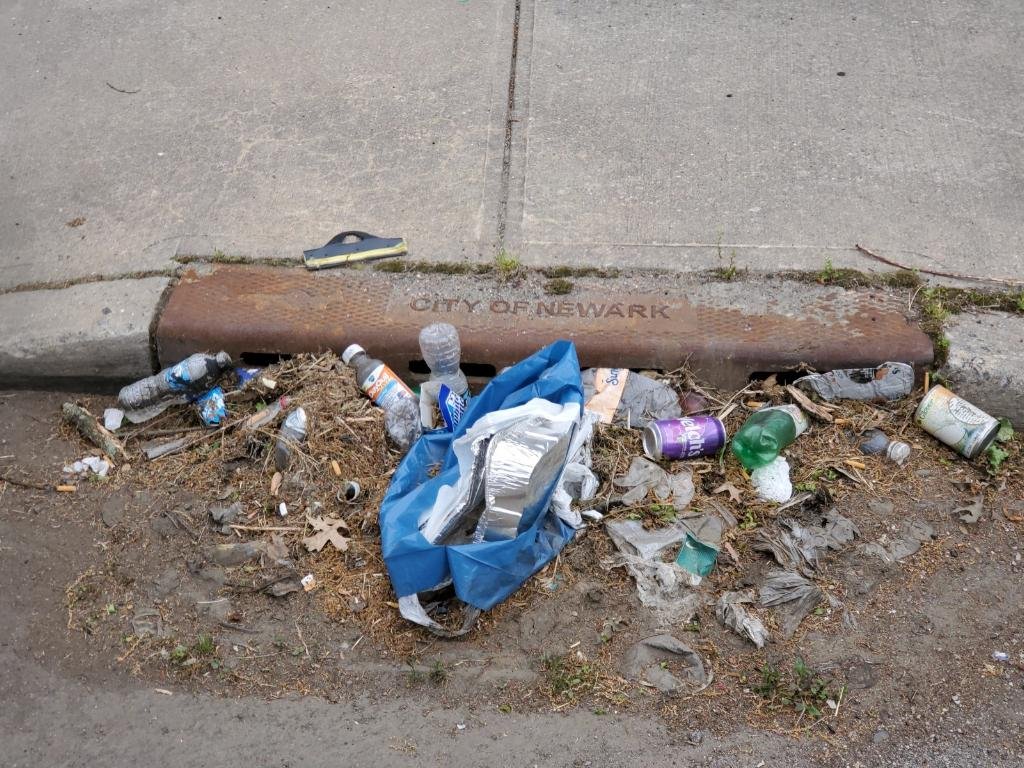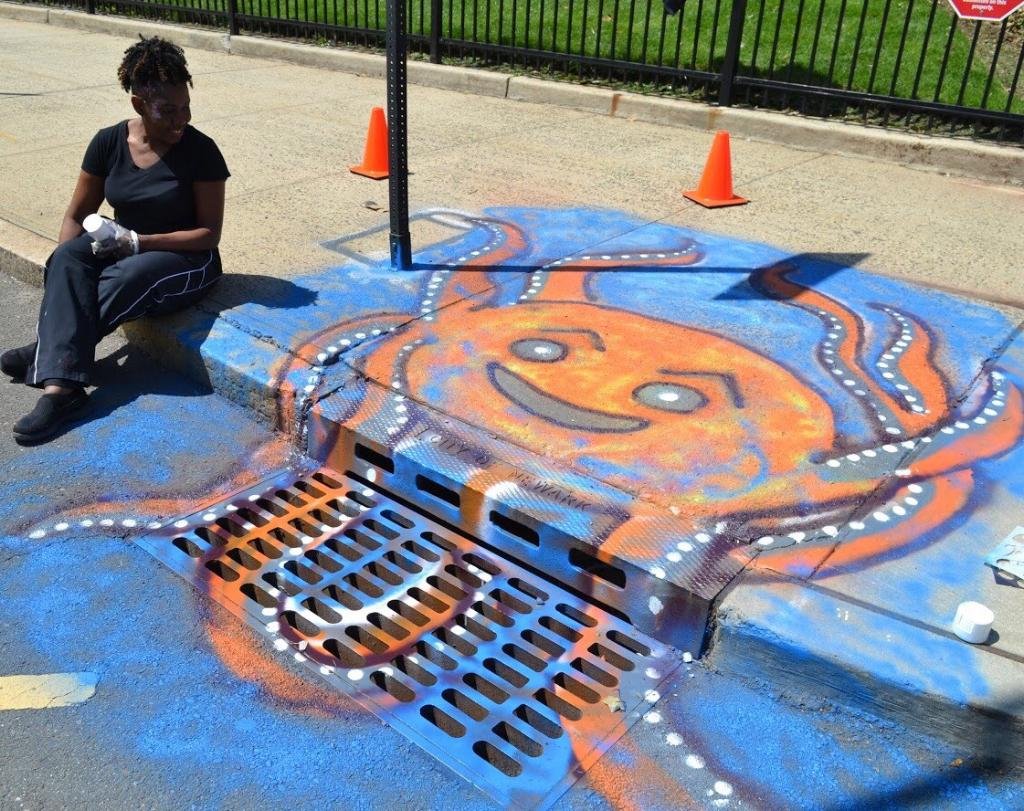Community activists leverage efforts for green infrastructure
Students from the Miller Street School assisted members of the Greater Newark Conservancy and participants in the Clean and Green: Newark's Transitional Jobs Program with planting a rain garden along Murray Street in Newark. (Photo courtesy of Nicole Miller)
This story was produced as part of the Northern New Jersey Media Collaborative Project "Stormwater Matters," a project focusing on stormwater management solutions in the state.
NEWARK, NJ—For low-income and marginalized communities in New Jersey's major cities, archaic sewer overflow systems pose serious environmental damage and health risks to residents who have historically experienced deep socio-economic inequalities and environmental racism. But with hurricane season just around the corner and the threat of raw sewage spilling into their streets, weary Newark residents are finally seeing the beginning of environmental justice in stormwater management as community organizers push their city to build baseline green infrastructure projects.
The plight of people in affected areas reaches across all of Newark’s five wards and across the nation. Formerly redlined neighborhoods, or majority Black neighborhoods that were deemed risky by the U.S. and local governments and denied services and investment in the 1930s and 1940s, have more homes in high-risk flood areas than majority-white neighborhoods. So it's not surprising that Black and marginalized communities in New Jersey are disproportionately impacted by combined sewer overflows, or CSOs, in which rainwater runoff, domestic sewage and industrial wastewater run through the same pipe into water treatment facilities.
Shashuna Atwater, a resident of Newark's Central Ward, said her basement flooded with raw sewage during Hurricane Ida as she and her daughter were carrying laundry down to the basement. Atwater said she froze, watching the brown water rise. “I was in shock,” she said.
To prevent combined sewers from overwhelming treatment facilities, untreated stormwater and human wastewater discharge directly into local waterways and overflow into affected communities, flooding streets and even homes—most of them in urban areas of the state. It's not unusual then for residents in Camden to have to pick up toilet paper from the local baseball field, or for kids in Newark to plod through rain puddles containing raw sewage.
Residents say that has to change.
"I have a daughter, and she loves to play in the rain like all kids do," said Nicole Miller, a Newark resident and co-chair of Newark DIG (Doing Infrastructure Green), a coalition of community organizations that advocate for green infrastructure to improve flooding resiliency and quality of life for Newark residents. "And so that child playing in the rain in the East Ward is playing in sewage, and that's not acceptable."
The history of disinvestment in predominantly Black and Brown communities and increased flood risk and water damage forces many homeowners in the U.S. to spend years repairing and rebuilding their homes instead of building home equity, and in New Jersey, many households received little relief after Hurricane Ida. About 63 percent of households that applied to FEMA, and only 30 percent of renters, received an award, and even then the state found that FEMA undervalued property damage.
Atwater, a household renter, applied and has waited a year for a follow-through. “Nobody got in contact with me, said they’ll be reaching back out," she said. "And that was a year ago almost. And so, what is FEMA for? Because I thought it was for emergency help.”
Atwater said she knows Hurricane Sandy survivors who have been waiting on FEMA for 10 years.
Flood damage for renters and homeowners in marginalized communities is a double-edged sword—residents take a financial hit when they receive little or no help from organizations set up for disaster relief, and they also face serious health risks when sewage backs up into their homes and streets.
Atwater said she was horrified, watching her basement disappear under water and the remnants of her family's life either float or sink—everything from her daughter's bed to her children's baby pictures. But the clean-up was even worse. "It's non-stop cleaning because you got to get the smell out, you got to get this stuff up, and who's cleaning that but the people who live there," she said. "Like eating wasn't an option for a couple of days because what you have to clean—it just turns your stomach."
It takes just a half inch of rain to overwhelm a CSO system and send backup sewage into streets and homes. Rainfall has increased by 10 percent over the last 20 years, and the problem will only get worse. With climate change, rainfall is expected to increase by another 10 to 20 percent by 2050.
A report published in The National Academies of Sciences, Engineering and Medicine found that there is a need for stronger coordination among the local, state, and federal agencies and community and environmental organizations to manage floods. And New Jersey has been trying to do that.
One of the main premises of New Jersey’s Stormwater Best Management Practices Manual is to have collaboration between county and municipal governing bodies, regulatory agencies and environmental organizations.
In 2015, the New Jersey Department of Environmental Protection (NJDEP) required CSO municipalities and sewer authorities to develop Long Term Control Plans (LTCP) to reduce the number of combined overflows and raw sewage spills. Affected municipalities were required to encourage public participation in selecting alternative management practices and to invite residents affected by sewage overflows to take part in a Supplemental CSO Team as a way to solicit public input. This included looking at existing community-based green infrastructure teams, such as municipal action teams.
Rosana Da Silva, a water quality manager from the New York-New Jersey Harbor & Estuary Program (HEP), who grew up in the Ironbound, said tackling stormwater management once meant sitting down with either a municipality's water department or office of sustainability. Even before the LTCP requirement, while helping lead the Rutgers Cooperative Extension (RCE) Water Resources Program with Extension Specialist Christopher Obropta, it was obvious that the way to address flooding and sewage overflows was to coordinate municipal departments and include community voices if they wanted to make a difference.
In 2009, the Rutgers Resources and Water Department received funding from NJDEP to implement a stormwater education program in Newark to reduce stormwater runoff in the city's combined sewer system. The program laid the foundation for obtaining a grant from the Camden County Municipal Utilities Authority (CCMUA) to start a green infrastructure initiative in Camden City. What followed was a series of meetings with community leaders and residents to discuss the magnitude of sewage overflows and green infrastructure opportunities, which led to the formation of municipal action teams.
Camden City was the first in the state to form a municipal action team—led by the CCMUA—and although Rutgers tried to replicate Camden’s action team in Newark, Obropta said it didn't work out that way. Unlike Camden, the team in Newark is run by community groups—the coalition called Newark DIG. “In Newark, it just kind of opened up to whoever wanted to be there,” he said.
Although an independent entity, DIG works in partnership with government organizations and city representatives, including the Newark Water and Sewer Department, Newark Office of Sustainability, the Passaic Valley Sewerage Commission, the Association of Jersey Environmental Commission and the Rutgers Water and Resources Department.
“You need that ownership in a municipality for something to have lasting efficacy,” said Miller. “The people in the area themselves have to believe in it, they have to take ownership of it, they have to be the drivers of it,” and they wanted Green Infrastructure.
If it wasn’t for the creation of DIG, green infrastructure “would have never been part of the plan,” Obropta said. “And every time you get five or 10 community people to show up to a meeting and talk about something that they really care about, that's going to influence the city council, you know, and I think that's a big piece of it.”
Newark has more green infrastructure projects today than any other CSO municipality in the state. The city plans to manage 214 acres of public land and has a list of 250 green infrastructure sites.
Originally, Newark planned to use traditional gray infrastructure to manage sewage overflows by installing large concrete tanks underground to hold stormwater. But community groups argued that spending money solely on gray infrastructure—a network of gutters, pipes, and retention basins—would be a wasted opportunity to do more for the city. Green infrastructure offers a host of other protections.
“We're not against gray infrastructure solutions, building tunnels, building storage tanks, and things like that, not in the least,” Miller said. “We just think they need to be coupled with surface-level green infrastructure because of the myriad benefits that are present.”
Not only can trees and gardens absorb rainwater and porous pavement capture it and slowly release it into a sewer system, but trees and increased green space can reduce the heat island effect. Formerly redlined areas are an average of five degrees hotter in the summer because they have more pavement and fewer trees to cool the air. Newark is second only to New Orleans on the list of the country’s most intense heat islands—an average 7.7 degrees hotter than surrounding areas.
The city’s asthma rate is also three times higher than the national average, but more roadside trees and rooftop gardens can help filter out particulates and improve air quality.
Community members plant a rain garden in Vailsburg Park in Newark. (Photo courtesy of Rosana Da Silva)
Using green infrastructure and green space to manage stormwater isn’t a new concept. Philadelphia and New York City spent an estimated $2.4 billion on green infrastructure, and in the early 1970s, a flood-control project in Arizona called the Indian Bend Wash emerged after residents objected to the construction of a huge concrete channel to carry away stormwater.
After a major storm in Arizona, residents approved the creation of Eldorado Park, an 11-mile open space that provided recreation and could carry away up to 30,000 cubic feet of floodwater per second.
Miller said they don’t expect green spaces or rain gardens in Newark to hold a Superstorm Sandy worth of water, but is the first line of defense against flooding and sewage overflow. “To capture those first couple inches of a rainstorm and to sort of help slow that water down,” she said.
One of the hurdles DIG faced when advocating for green infrastructure was how most engineers and consultants are used to building gray infrastructure, and community engagement isn't usually part of their job description. Obropta, a former engineering consultant, said conversations around beautifying neighborhoods and community involvement "scares the hell out of consultants. You know, these engineers, they can't talk to people," he said, but Newark DIG can.
By speaking with engineers, officials and community members, DIG helps bridge the gap in communication about what can be done or should be done in the city to address stormwater. They're able to educate the community on stormwater management and state permits, the role of municipalities, and the challenges of effectively addressing sewage overflows.
“I think the importance of municipal action teams is that they are so connected to the community that they can make these informed decisions on investments that need to be made,” said Da Silva. “As well as maximizing the additional benefits that come with infrastructure to the community.”
Miller said they were able to solicit feedback from the community in advance of presenting their ideas to the Newark City Council and share with people what was included in the LTCP. Through their connections, they bring together technical expertise and local knowledge to better meet community needs.
“I have actual mail carriers send me pictures of catch basins that need to be cleaned because we've sent out the word that the catch basins, when they get clogged up, that's immediate flooding for that area,” Miller said.
While a municipal action team like DIG is an effective way for municipalities to discover the pressing issues in a community and figure out what can be done about them, funding remains a serious barrier. Not only is there limited money for green infrastructure projects in the state, it’s almost entirely out of mind when it comes to community engagement.
“If we're going to rely on local organizations to coordinate and communicate to residents and recognize them as effective communicators, then I think we need to provide them with funding to do just that,” said Da Silva.



The Ironbound Community Corporation (ICC), a partner of DIG, helped Atwater fund her recovery after Ida. "Not that it covered so much, but it was, you know, ‘Wow, somebody cares,’" she said. "If it weren't for them, I wouldn't have gotten one bit of help. Because FEMA is the first people you think to go to, am I correct? Funding is put away for an emergency. And they were the last people—not to help—that didn't help."
Funding barriers can limit who gets a seat at the table as well, potentially keeping people impacted by flooding out of conversations about stormwater management issues and how funding should be used. “We need to know what those issues are and how we can combine both water quality goals and design with social needs in mind as well,” Da Silva said.
Since 2020, municipalities have been waiting for the NJDEP to approve their control plans for containing stormwater, which will establish what projects municipalities can do over the next few years. But Newark has a shortlist of 17 projects that are ready to go as soon as they identify a project vendor.
With the help of residents, technical advisors and city officials, DIG has been working on identifying where green infrastructure projects can go and applying for money to get projects done.
One project, the CityPlex 12 Green Streets project in the Central Ward, will likely begin in January 2023. Newark was awarded around $1 million from NJDEP to put trees, shrubs, and groundcover to capture stormwater around the CityPlex movie theater and adjacent streets.
“And we couldn't do that if it was just the City of Newark, or if it was just DPW,” said Miller. “Or if it was just a group of concerned citizens and business owners, or if it was just Rutgers working by itself. Like we have to be all working together.”
For example, it was NY/NJ Baykeeper, a partner of DIG, that was able to get the funding to commission Rutgers to draw up green infrastructure designs, which allowed DIG to present the idea to the NJDEP and get approval.
While green infrastructure can provide a range of long-term benefits, it requires more labor than gray infrastructure. Often, there is limited or no maintenance done at the local level due to a lack of resources, knowledge base, technical expertise and training programs. Without regular maintenance, green spaces can end up dying or becoming an overgrown nuisance, proving a challenge for many municipalities.
But in Newark, DIG helped launch a workforce development program called Newark Greenworks to train local Newark residents to get national certification in green infrastructure since these projects need to be regularly maintained and built.
“The DEP award actually allows us to fund some of the green infrastructure trainees to come in and be on site for the construction as like an apprenticeship program,” said Miller. Since 21 municipalities around the state will be doing green infrastructure to address their CSO and sewage problem, they will need people who are certified and qualified to build it.
A dedicated workforce in Newark can also act as an extension of community engagement since the people working on the projects will live in the community and can engage their neighbors, families and friends in conversations about green infrastructure and stormwater management.
Still, the LTCP and green infrastructure projects are far from perfect. Several plans show that many municipalities with CSO systems are doing the minimum required, including the Passaic Valley Sewerage Commission in Newark, which agreed to collect no less than 85 percent of sewage-stormwater volume, meaning that whatever the plan is, it can still release 15 percent of total stormwater-sewage volume, or billions of gallons of sewage a year.
Newark also has until 2060 to achieve their goal. Although money is usually the key to getting more done and faster, Da Silva pointed out that the City of Newark was able to replace lead pipes in less than three years. “It shows you it is possible. Like you can do this, and it doesn't have to take 20 years to fix it. It can be done, I think, if we get out of our own way sometimes.”
Time is of the essence.
Newark needs to attack the problem before another storm strikes and sewage becomes a bigger problem, Atwater said. The city can’t afford to wait, especially as hurricane season in New Jersey is on the horizon.
“Prevention is handling the problem before it hits,” she said. “And even with fixing up the city, where's [the help for the] minority, where's the inner city? Funding comes there last, if at all. If at all. Like it's terrible Down Neck how we live with all of this sewage backing up. It’s really terrible.”
In Part II and III of this series, PSA will look at two other cities—Paterson and Camden—and their level of engagement to push their municipalities to address sewage overflow and environmental damage caused by archaic overflow systems, and what reparative justice can look like.


